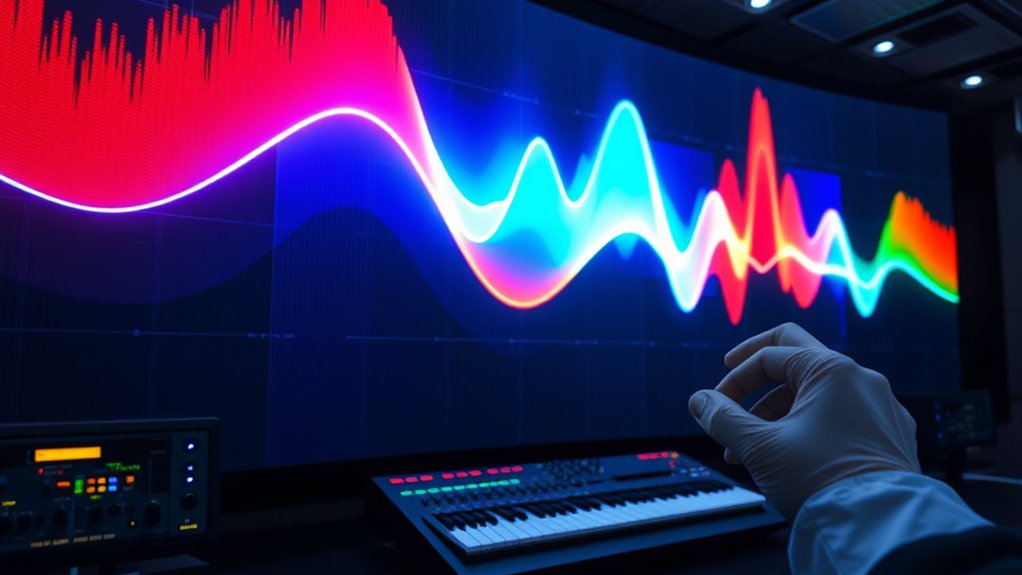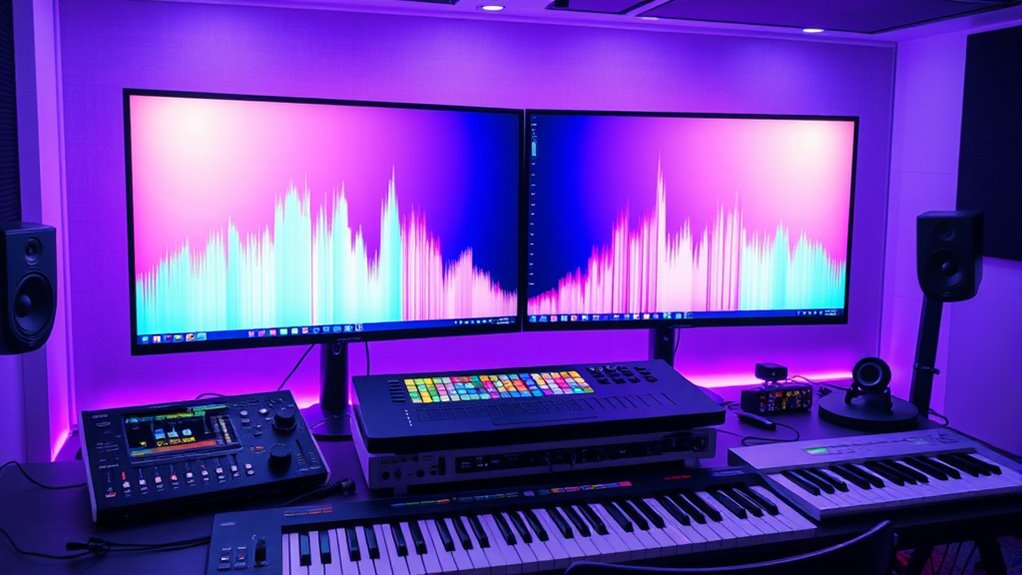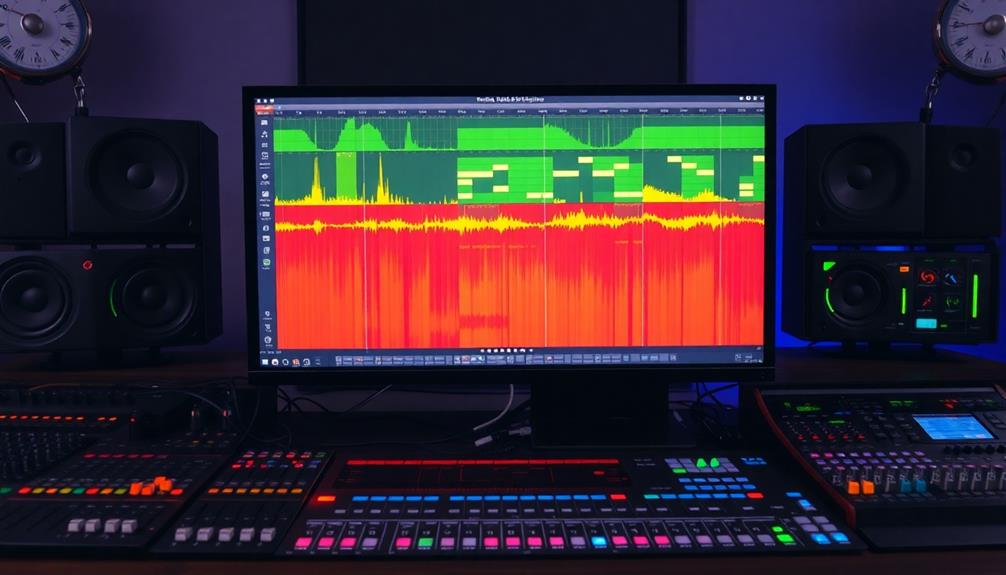Spectral morphing lets you blend two sounds into a new, hybrid instrument by gradually transforming their spectral features. You analyze their spectra—like frequency and amplitude—and interpolate between them using software tools. This creates smooth, natural transitions that merge characteristics, allowing for innovative sound design. While it offers exciting possibilities, it also comes with challenges like artifacts and computational demands. Exploring further reveals how to master these techniques and access unique sonic worlds.
Key Takeaways
- Spectral morphing gradually blends spectral features like frequency and amplitude from two sounds to create a new hybrid instrument.
- It involves spectral analysis, visualization, and interpolation techniques to ensure smooth, natural transitions between sounds.
- Tools such as MATLAB, Python, or specialized audio software facilitate spectral analysis and manipulation for sound fusion.
- Artistic applications include developing unique textures, transforming sounds, and designing hybrid instruments for innovative soundscapes.
- Challenges include maintaining high audio fidelity, avoiding artifacts, and managing computational complexity during the blending process.
Understanding Spectral Morphing and Its Foundations

Spectral morphing is a technique that transforms one sound into another by gradually changing their spectral features. This process relies on spectral blending, where the spectral components of two sounds are combined seamlessly over time. By manipulating the spectral content, you can achieve sound fusion, creating a smooth passage that feels natural and organic. Spectral morphing works by analyzing the frequency, amplitude, and phase information of each sound, then blending these features to produce a new, hybrid sound. This technique allows you to craft unique sonic textures and instruments, merging characteristics of different sounds into a cohesive whole. Understanding spectral blending and sound fusion forms the core of spectral morphing, enabling you to manipulate audio in innovative and expressive ways. Recognizing the importance of emotional support can help creators address listener reactions and foster a deeper connection with their audience.
The Process of Spectral Analysis and Spectrograms

To effectively perform spectral morphing, you first need to analyze the sounds involved. Spectral analysis breaks down audio into its frequency components, revealing how different parts contribute to the overall sound. Spectrograms visualize this process, displaying frequency blending over time, which helps you understand the relationship between sound textures. With spectral analysis, you can observe how the timbral transformation occurs as frequencies shift and blend between sounds. This insight allows you to target specific spectral features for manipulation. By examining spectrograms, you identify key elements like harmonic content and noise components, guiding your morphing process. This detailed analysis lays the foundation for seamless sound blending, ensuring the final instrument captures the desired tonal qualities.
- Visualize frequency distribution over time
- Identify dominant harmonic and noise components
- Track spectral changes during timbral transformation
- Fine-tune frequency blending for smooth transitions
Techniques for Interpolating Between Spectral Features

You can smoothly shift between spectral features using various interpolation methods. Techniques like linear and spline interpolation modify spectral data to create seamless morphing effects. Cross-spectral morphing further enhances this process by combining multiple spectra for more complex transformations. Incorporating active listening and empathy into the process can improve the accuracy and emotional resonance of spectral blending.
Spectral Interpolation Methods
When interpolating between spectral features, selecting the right method is essential for achieving smooth and accurate results. Techniques like linear interpolation, spectral morphing, and phase vocoding help you blend sounds seamlessly. In quantum acoustics, spectral interpolation can reveal subtle sound transformations, enhancing harmonic synthesis. These methods allow you to carefully control how spectral components transition, preserving musicality. You might also explore frequency warping or convex combinations for more nuanced morphs. Understanding these approaches enables you to craft unique sonic textures. The goal is to generate natural-sounding transitions that respect harmonic relationships without artifacts. By choosing the appropriate spectral interpolation method, you guarantee your sound morphing process maintains clarity and musical coherence, crucial for advanced spectral morphing projects. Incorporating spectral features can further improve the fidelity and expressive quality of your sound transformations.
Cross-Spectral Morphing Techniques
Cross-spectral morphing techniques focus on directly interpolating between spectral features of different sounds to create smooth, cohesive shifts. You can blend sounds by adjusting spectral components, often using digital algorithms that mimic analog filters or hardware synthesizers. These methods enable precise control over timbral changes, producing natural transitions. For example, you might interpolate between two spectral peaks or modify their amplitudes and phases. Additionally, spectral resolution plays a crucial role in determining the clarity and detail of the morphing process.
Tools and Software for Spectral Morphing

Numerous tools and software options facilitate spectral morphing, enabling you to seamlessly blend and transform spectral data for mesmerizing sound fusion. These programs help you manipulate spectral features to create unique hybrid sounds, making spectral blending more accessible. Advanced sound therapy techniques, such as sound vibrations, are also explored within spectral manipulation to enhance healing qualities.
Discover powerful tools that make spectral morphing seamless and inspire innovative sound design.
- Audacity: Free, open-source software with spectral editing tools suitable for basic sound fusion projects.
- iZotope RX: Advanced audio repair suite that offers spectral editing for precise sound manipulation.
- MATLAB & Python Scripts: Customizable platforms for detailed spectral morphing using specialized algorithms.
- Melodyne: Pitch and time correction software with spectral editing capabilities for subtle sound shaping.
These tools empower you to craft innovative sounds by combining spectral data efficiently, expanding your creative possibilities in spectral morphing.
Step-by-Step Guide to Creating a Hybrid Sound

Creating a hybrid sound through spectral morphing begins with selecting two audio sources you want to blend. Start by choosing one sound with rich acoustic characterization and another that highlights unique tonal qualities, such as an analog synthesis element. Load these sources into your spectral morphing software. Next, analyze their spectral content to understand their frequency distributions. Adjust parameters like spectral crossfade, ensuring a smooth progression between the sounds. Focus on preserving the acoustic characteristics that define each source, blending them seamlessly. Fine-tune the morphing process until you achieve a balanced hybrid. This method allows you to combine the warmth of analog synthesis with the organic qualities of acoustic sounds, resulting in a new, expressive instrument. Incorporating advanced sound design techniques can further refine the hybrid, unlocking more creative possibilities.
Creative Applications and Artistic Possibilities

Have you ever wondered how spectral morphing can expand your artistic horizons? This technique opens new avenues in sound synthesis, allowing you to blend diverse sounds creatively. With spectral manipulation, you can craft entirely unique textures and atmospheres, pushing the boundaries of traditional instruments. You might experiment with transforming everyday sounds into musical landscapes or combining organic and synthetic elements for innovative compositions. Spectral morphing enables you to develop new timbres that wouldn’t exist otherwise. It also invites cross-genre experimentation, blending sounds from different cultural or stylistic origins. By leveraging these techniques, you craft immersive sound worlds or evoke specific emotions. The artistic possibilities are virtually limitless, inviting you to explore and redefine what’s possible within your musical landscape.
Challenges and Limitations of Spectral Morphing

While spectral morphing offers exciting artistic possibilities, it also presents several challenges that can limit its effectiveness. One key issue is maintaining high audio fidelity; the process can introduce artifacts or distortions that reduce sound quality. Achieving seamless blends requires precise spectral analysis and manipulation, which isn’t always straightforward. Additionally, spectral morphing demands significant computational complexity, making real-time processing difficult without powerful hardware. This can hinder live performances or interactive applications. Variations in source recordings, such as differing timbres or recording conditions, can further complicate results. Consequently, you might find that some morphs sound unnatural or lack smoothness. To address these issues, researchers are exploring advanced algorithms and hardware solutions to improve processing speed and quality. Overcoming these challenges involves balancing quality with computational resources, often requiring careful parameter tuning.
Examples of Spectral Morphing in Music and Sound Design

Spectral morphing has been effectively employed in various music and sound design projects to craft unique auditory experiences. You might hear it in hybrid instruments created through analog synthesis, blending vintage warmth with modern textures. Digital filtering allows sound designers to smoothly shift between different timbres, transforming one sound into another seamlessly. For example, morphing a guitar tone into a synthesizer sound creates dynamic textures. Sound designers also use spectral morphing to craft evolving soundscapes in film scores, where blending organic and synthetic elements heightens emotional impact. Additionally, artists combine acoustic recordings with electronic textures, leveraging spectral techniques to produce innovative sounds. These examples showcase how spectral morphing unlocks creative potential by merging diverse sonic worlds effortlessly. Moreover, cultivating creative practice through experimentation and exploration can lead to even more groundbreaking sound design techniques.
Future Trends and Innovations in Spectral Processing

Advancements in computational power and algorithm design are driving rapid innovation in spectral processing, opening new possibilities for real-time manipulation and immersive sound experiences. Quantum acoustics is emerging as a frontier, enabling the exploration of sound at a subatomic level and offering unprecedented control over spectral qualities. Neural synthesis is also transforming the landscape, allowing you to generate complex spectra through deep learning models that learn from vast datasets. These innovations enable more precise and expressive spectral morphing, pushing the boundaries of sound design. Additionally, understanding spectral qualities is fundamental for developing more nuanced and dynamic sound transformations. Future trends will likely focus on integrating quantum principles with neural synthesis, creating hybrid systems that offer faster processing and richer sonic textures. As these technologies evolve, you’ll have even greater tools to craft unique, evolving soundscapes that were previously unimaginable.
Tips for Experimenting and Pushing Sonic Boundaries

Pushing sonic boundaries requires more than just access to cutting-edge technology; it demands a willingness to experiment and challenge traditional concepts of sound. To master spectral morphing and achieve unique sonic blending, you should embrace imperfections like spectral artifacts, which can add character or inspire new ideas. Don’t shy away from pushing parameters beyond conventional limits—this often leads to unexpected textures. Use modulation creatively to morph sounds gradually, revealing hidden spectral details. Exploring characteristic sound qualities can help you better understand how to manipulate spectral features effectively.
- Experiment with extreme spectral artifact buildup for distinctive textures
- Combine diverse sound sources to challenge typical sonic boundaries
- Adjust blending parameters slowly to discover new morphing effects
- Listen critically to subtle spectral changes that reveal novel sonic opportunities
Frequently Asked Questions
Can Spectral Morphing Be Applied to Real-Time Audio Processing?
You wonder if spectral morphing can be used for real-time audio processing. It’s possible, but you need to take into account latency challenges that come with analyzing and blending sounds quickly. With advancements in processing power and optimized algorithms, you can achieve near real-time performance. However, managing latency remains essential to guarantee seamless audio output, making spectral morphing a practical tool for live performances and interactive applications.
How Does Spectral Morphing Impact Audio Quality and Fidelity?
You might wonder how spectral morphing affects audio quality and fidelity. It often enhances sound design by blending textures and timbres seamlessly, but if not done carefully, it can introduce artifacts or reduce clarity. When managed well, it preserves high audio fidelity and maintains sound quality, allowing you to create rich, unique sounds. However, poor implementation may compromise clarity, so attention to detail is key to achieving peak results.
What Genres or Styles Benefit Most From Spectral Blending Techniques?
You’ll find that genres like experimental fusion and genre innovation benefit most from spectral blending techniques. These methods allow you to creatively merge sounds, opening new sonic possibilities and pushing traditional boundaries. By blending textures, you can craft unique soundscapes and innovative styles that stand out. Spectral morphing empowers you to experiment freely, adding depth and complexity to your music, making it ideal for pushing artistic limits and exploring new musical territories.
Are There Limitations to Combining Very Different Instrument Sounds?
Imagine mixing vibrant paint colors; some combine seamlessly, while others clash. When blending very different instrument sounds, you might face limitations in instrument compatibility and sonic coherence. You’ll notice that dissonant timbres can create muddy or unnatural results, making it hard to achieve a harmonious blend. To get the best outcome, consider how well the sounds complement each other, ensuring the spectral elements mesh smoothly without losing clarity.
How Can Spectral Morphing Be Integrated Into Live Performance Setups?
You can integrate spectral morphing into live setups by using a visual interface that allows real-time control of sound blending. Hardware integration is key, so connecting morphing software with your instruments or MIDI controllers enables seamless manipulation during performances. This setup lets you dynamically blend sounds, creating unique textures on the fly. Make sure your system is optimized for low latency, ensuring smooth progressions and an engaging experience for your audience.
Conclusion
By mastering spectral morphing, you unlock the power to create sounds so astonishing, they’ll blur the line between reality and imagination. Imagine blending voices, instruments, or noises into entirely new worlds—your sonic palette becomes limitless. With each experiment, you push boundaries further, transforming ordinary sounds into extraordinary masterpieces that could redefine music and sound design forever. Get ready to unleash your creativity and make the impossible audibly real—spectral morphing is your gateway to sonic innovation!









